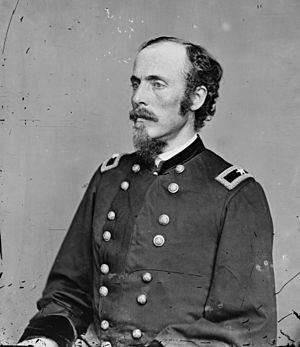Emerson Opdycke facts for kids
Quick facts for kids
Samuel Emerson Opdycke
|
|
|---|---|

Emerson Opdycke
|
|
| Born | January 7, 1830 Hubbard, Ohio |
| Died | April 25, 1884 (aged 54) New York City, New York |
| Place of burial |
Oakwood Cemetery, Warren, Ohio
|
| Allegiance | United States of America Union |
| Service/ |
United States Army Union Army |
| Rank | |
| Battles/wars | |
Samuel Emerson Opdycke (born January 7, 1830 – died April 25, 1884) was a businessman and a brave leader in the Union Army during the American Civil War. He rose to the rank of brigadier general.
Early Life and Family
Samuel Emerson Opdycke was born on a farm in Hubbard, Ohio. His family had a history of serving in the military. His father fought in the War of 1812, and his grandfather was a captain in the New Jersey army during the American Revolution. Samuel's older brother, Henry, also served in the Civil War.
Samuel went to school in Hubbard. Before the war, he worked in different businesses in Ohio and California.
Fighting in the Civil War
After the first big battle of the war, the First Battle of Bull Run, Opdycke joined the army. He became a first lieutenant in the 41st Ohio Infantry in August 1861. As a captain, he fought in the Battle of Shiloh.
In September 1862, he left his first group to help create a new one, the 125th Ohio Infantry. He quickly became a lieutenant colonel and then a colonel. His group became famous for bravely defending Horseshoe Ridge at the Battle of Chickamauga.
Later, during the Battles for Chattanooga, Opdycke's men were among the first to reach the top of Missionary Ridge. He also fought through the Atlanta Campaign with the Army of the Cumberland. He was badly hurt at the Battle of Resaca but recovered and led an attack at the Battle of Kennesaw Mountain.
The Battle of Franklin
Opdycke showed great courage and smart thinking at the Battle of Franklin. As the Confederate army, led by John Bell Hood, came closer, Opdycke's commander told him to set up defenses in front of the main Union line.
Opdycke disagreed with this order. He argued and then moved his men to a safer spot behind the main defenses. This turned out to be a very wise decision.
When the Confederate attack broke through the Union line, Opdycke quickly moved his men into position. They faced many Union soldiers running away, with Confederates right behind them. Opdycke ordered his group to charge forward.
At the same time, his corps commander, David S. Stanley, arrived. Stanley saw Opdycke leading his men and knew he was doing exactly what was needed to save the Union army. Opdycke's quick counterattack turned the battle around. The Union Army won an important victory.
For his brave actions at Franklin, Opdycke was given a special honor, becoming a brevet major general. He was later promoted to a full brigadier general in July 1865.
Life After the War
Opdycke left the army in 1866. He moved to New York City and started a business selling clothing and fabrics. He also wrote several articles about the war and helped other soldiers who had served.
Samuel Emerson Opdycke passed away in New York at age 54. He is buried in Oakwood Cemetery in Warren, Ohio.

